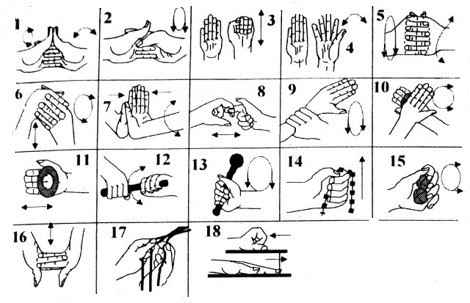Hereditary diseases of the nervous system

Hereditary diseases of the nervous system can manifest themselves in various forms. In the class of diseases include myopathies, i.e. diseases of the nervous system, in which case genetic disorders manifest themselves in the form of muscle damage. A common sign for these is weakness in muscles, progressing with time.
Muscular atrophy.
The cause of the development of muscular atrophy in the patients consists in one case in metabolic disorders in the muscle tissues, and in others - disorders of the nervous regulation of this metabolism.
The disease begins with the fact that the children are inactive, they change their gait, which begins to resemble a duck, a wadded coat. Physical exercise increases the manifestation of muscle weakness. To raise the floor from a sitting position, the sick child must resort to the help of his hands, with the help of which he first leans on the floor, and only then on his feet. Difficulties in walking can lead to complete immobility of the patient.
In the case of an external examination of the patient, his legs and hands due to atrophy look sucked, the waist is like an "aspen", the shoulder blades begin to protrude above the covering of the back.
The development of muscle volume, sometimes found in certain types of myopathy, is deceptive. This pseudohypertrophy, arising in connection with the fact that the increase in muscle mass is caused by the deposition in it of inclusions of fat, while the muscle itself looks atrophied. Pseudohypertrophic muscles can be legs, for example, calves, and also on arms - deltoid.
Myotonia Thomsen.
There is such a neuromuscular hereditary disease as Thomsen's myotonia. At patients it muscles are strained and dense to the touch. The appearance of such patients is characterized by the athlete's physique, they look like gymnasts, wrestlers. But they have a very low muscle strength. They have certain difficulties and strains in the exercise of some kind of muscular effort. Also spasms of muscles are frequent. The walk is awkward, constrained and "stumbling".Slowly the extension and flexion of the hand into the fist is performed. Muscle spasms also occur when chewing food. Myotonia Thomsen meets with relatives in any generation, because there is a dominant type of inheritance.
In the case of other neuromuscular diseases, there may be a correlation of muscle weakness with a decrease in muscle tone, overdistension and looseness of the joints of the legs and hands in the event of movement. The formation of such changes is observed at the birth of the child and grows in the future.
In general, for the whole group of neuromuscular inherited diseases, it is characteristic that the earlier the disease starts, the more severe its course will be.
Hereditary diseases can be transmitted either by recessive, and in the case of individual forms - by a dominant trait. Ill girls and boys, but severe forms are most often found in boys.
Diseases with impaired movement.
Now consider the diseases of the nervous system with disturbances in motion. They are diverse. We will only consider some of them.
Doctors are well aware of the disease Stryumpellya( named after the name of the scientist who described it).It is characterized by the fact that the child at the end of the first decade of life is limited by the mobility of the legs in the region of the knees, the gait becomes more complicated, the muscle tension increases, and the patients move as if on stilts. The disease is slowly progressing. The type of inheritance in this case is autosomal recessive, but there are situations with other variations of inheritance. Diseases of the nervous system with impaired movement often can be manifested by ataxia, i.e., disorders of motor coordination. There are also family ataxia species. One of them is Friedreich's disease. The disease begins at the age of 5-15 years. Previously, the child has a disorder of gait, it becomes more sluggish, awkward, the diseased move with difficulties. The gait itself is characterized by the fact that patients during the walk raise their widely spaced legs and hit hard on the floor with their heels. Over time, from the lower extremities, ataxia gradually spreads to the arms and trunk. The child's speech is increasingly intermittent, slow and jerky. On the legs a peculiar deformation of the feet is formed, a substantial deepening of their arch occurs. The disease slowly begins to progress. It can be found at several sisters and brothers. Often it has an autosomal recessive form of transmission. There are varieties of family ataxia, beginning in more adult years. They are often correlated with a variety of types of dementia.
Disturbances in movements in the case of hereditary diseases can also be expressed in the form of violent movements, i.e., those that are formed in the diseased person in addition to his own desire.
Huntington's disease of Huntington.
Known is a disease, such as Horea Huntington. It is often formed at the age of 30-40 years and can be characterized as violent movements in the form of small-scale multiple jerks. Patients retain the ability to independently move, eat, dress, but the implementation of these acts is combined with a range of unnecessary involuntary movements. In the case of walking, they seem to dance, throw their legs and arms, significantly swing the body, nod their head. During the conversation they grimace, smacking their tongues. Later, patients develop dementia. The disease has a dominant type of inheritance. A wide spread of this disease is associated in some areas of the planet with late launch of clinical manifestations. So, for example, in the US scientists were able to trace the transfer of the gene of this disease. In the 18th century from the old England on the eastern coast of the American continent came three brothers, who were the carriers of the dominant gene of Horea Huntington. Their grandsons, children and great-grandsons, having reached mature years were ill with this disease and further distributed it.



